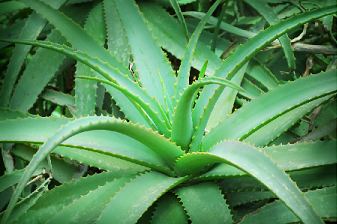Aloe (often called aloe vera) produces two substances, gel and latex, which are used for medicines. Aloe gel is the clear, jelly-like substance found in the inner part of the aloe plant leaf. Aloe latex comes from just under the plant’s skin and is yellow in color. Some aloe products are made from the whole crushed leaf, so they contain both gel and latex.
Contents
Uses
Aloe medications can be taken by mouth or applied to the skin for
- osteoarthritis
- bowel diseases including ulcerative colitis
- fever
- itching and inflammation
- stomach ulcers
- diabetes
- asthma
- for treating some side effects of radiation treatment.
However, most people use aloe gel topically, as a remedy for skin conditions including
- burns
- sunburn
- frostbite
- psoriasis
- cold sores
- Some people also use aloe gel to help surgical wounds and bedsores heal faster. There is some science supporting these uses. Some chemicals in aloe gel seem to be able to increase circulation in the tiny blood vessels in the skin, as well as kill bacteria.
Benefits
- Aloe gel might cause changes in the skin that might help diseases like psoriasis.
- Aloe seems to be able to speed wound healing by improving blood circulation through the area and preventing cell death around a wound.
- It also appears that aloe gel has properties that are harmful to certain types of bacteria and fungi.
- Aloe latex contains chemicals that work as a laxative.
Cautions
- Taking aloe latex by mouth is likely unsafe, especially at high doses. There is some concern that some of the chemicals found in aloe latex might cause cancer. Additionally, aloe latex is hard on the kidneys and could lead to serious kidney disease and even death.
- A number of years ago, the FDA became concerned about the safety of aloe latex, which was an ingredient in many laxatives. The FDA’s concern was heightened by the fact that people develop a kind of “tolerance” to aloe latex. They have to take more and more of it to get a laxative effect. That means they are likely to increase their dose — and their risk. The FDA requested safety data from the makers of laxatives that contained aloe latex, but they didn’t comply, possibly because of the expense involved in doing safety studies. In the absence of safety data, the FDA required manufacturers to remove or reformulate all over-the-counter (OTC) laxative products in the U.S. market that contained aloe. The deadline for compliance was November 5, 2002.
Interactions
- If you take any drugs regularly, talk to your doctor before you start using aloe supplements. They could interact with medicines and supplements like diabetes drugs, heart drugs, laxatives, steroids, and licorice root.
References
Source: WEBMD, “Aloe Vera”, web article- Reviewed by David Kiefer, MD on October 31, 2014; www.webmd.com/vitamins-supplements/

